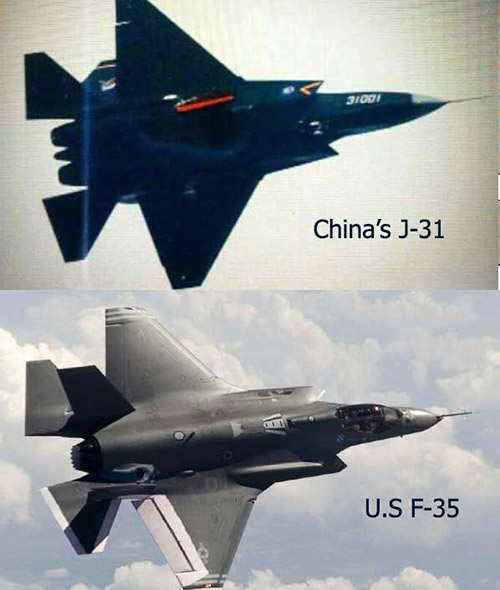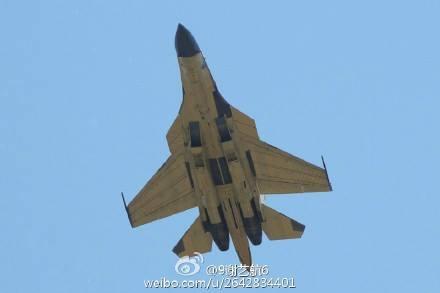If confirmed, the Chinese would have developed, absolutely secretly, a fighter based on the Sukhoi Su-27 airframe, similar to the Su-34 “Fullback”. The point is that the Russians have not issued any licenses to the Chinese to produce their latest generation fighter-bomber at home.
The photo, published at 00,46 this night on the Chinese website Weibo (controlled by the government authorities since 2009), would show a platform similar to the Sukhoi Su-34 in flight without the canard fins (and this is plausible by virtue of the other platforms owned ). The Chinese fighter-bomber, however, is much more impressive than its Russian counterpart. The problem is to understand what has been published, considering that the Chinese do not use the same propaganda (as the Iranian one) for internal use.
The timing is curious to say the least, a few hours fromepisode of the Islands Spratly. To think even for a second that it could be a leak of news for an aircraft developed in secret is practically impossible considering that the Weibo site is indeed a microblogging with more than 500 million subscribers, but it is also under strict control and Chinese government monitoring. Sure, it could happen, but even now the photos are available and haven't been removed.
It could be a fake, but one wonders why, considering that China does not need to flex its muscles (whether real or fake) compared to other countries. Just to give an example: just a few hours ago, the Chinese government leaked photos of the first aircraft carrier built entirely at home in the Delian shipyard through a site of "military enthusiasts". The Chinese themselves then released more photos of another shipyard in the Shanghai area where a second carrier is being built. While possible, it seems unlikely that the fighter was just a fake. But if not, the Chinese would have managed to develop a version that is clearly inspired by the Russian Su-34. And if so, there would be other dark spots.
Russia, which has 73 Su-34 in service, a platform designed for the role of attack and medium-range bombing, jealously guards the entire project and has not sold the “Fullback” to any country. The latter went into production only in 2005. Speculations, therefore, but the photo has attracted particular attention in the West. Analyzing it carefully, it appears evident that the aircraft is a derivative of the Su-27 family (the airframe guarantees excellent maneuverability and autonomy, which is why it was used to develop the Fullback). It could be plausible to hypothesize a new platform, freely inspired by the information available on the Su-34.
The industrial espionage trail is also not to be discarded. Even in this case, however, although the Chinese are a bit "careless", in replicating patents without authorization, it would be counterproductive (already in 2008, in the context of technical-military cooperation between Russia and China, an agreement was signed on protection of intellectual property). But if that were the case, one would ask why, considering the excellent relations between the two countries. Suffice it to say that between 1991 and 1995, the Chinese bought 48 Su-27s, building another 200 under license under the name of Shenyang J-11. Beijing also purchased 100 Su-30MKK and MK2 with updated avionics and multi-role capability, but lacking vector thrust and canard flaps. And that's not all because the Chinese have also bought 48 Su-33 multi-role fighters. Little is known about the immortalized fighter, nothing about avionics. Probably some form of electron-scanning radar and electro-optical wiper systems. The propulsion system appears to be the same as that of the Chinese Flankers.
It could be a prototype. It is undeniable, however, that the Chinese Su-34 shocked the West for having appeared on the scene. In fact, no one knew of the existence of this platform. We know that China's fifth-generation fighter, the Chengdu J-20, will reach Initial Operational Capacity by 2018. The Chengdu J-20 is likely to play the role of long-range air supremacy in every area of the Western Pacific region.
 The Shenyang J-31 "Falcon Hawk", on the other hand, should be the ideal platform in the “anti-access area-denial” (A2AD) strategy in the Western Pacific. The J-31 has always been considered the cheap alternative to the F-35 and is expected to be adopted in the future also by the allies of China and by those who cannot buy the “original” JSF. The Shenyang J-31, (mostly for propaganda), is defined as a fifth generation fighter, even if for the West it is considered fourth. The fighter has similarities with the Russian PAK-FA T-50, although it would be more correct to say that the design of the J-31 resembles that of the F-35. The Shenyang J-31 "Falcon Hawk", flew for the first time on October 31, 2012. Designed (probably) thanks to a process of reverse engineering from a downed American stealth fighter, it was to become the fifth generation Chinese embarked fighter, becoming in effect the antagonist of the F-35 Lightning II. But something seems to have gone wrong. China, which has only one aircraft carrier in service, has reduced the real value of the aircraft, proposing it to second level air forces such as Brazil, Pakistan and some countries of the Middle East. It appears that the technology created was not originally meant for export, but built for internal use. Oddly enough, the Chinese press last year also lashed out at the aircraft, arguing that the aircraft would not be able to take off from a heavily armored aircraft carrier. Analyzing the photos, the J-31 appears to be little more than a cheap copy of an American fighter jet. Indeed, the nose section, the twin tails as well as the trapezoidal wings represent the distinctive lines of Western stealth design. Arguably, the J-31 is based on technology extracted from American planes lost in battle, such as the F-117 stealth shot down in 1999 in Serbia. It is also true that in recent years, targeted cyber attacks have been carried out against Lockeed Martin. Chinese hackers, therefore, may have managed to get their hands on some useful technical drawings of the Raptor and the F-35. But it's also true that copying American technology doesn't just need projects. It is also necessary to be able to transform them into reality. However, to date it is impossible to compare the J-31 with other fighter jets, given the secrecy that still surrounds it. We know that its fire control radar, as well as subsystems and avionics are entirely Chinese. Its design certainly makes it look like a fifth generation fighter, but we do not know the materials used for the aircraft's skin.
The Shenyang J-31 "Falcon Hawk", on the other hand, should be the ideal platform in the “anti-access area-denial” (A2AD) strategy in the Western Pacific. The J-31 has always been considered the cheap alternative to the F-35 and is expected to be adopted in the future also by the allies of China and by those who cannot buy the “original” JSF. The Shenyang J-31, (mostly for propaganda), is defined as a fifth generation fighter, even if for the West it is considered fourth. The fighter has similarities with the Russian PAK-FA T-50, although it would be more correct to say that the design of the J-31 resembles that of the F-35. The Shenyang J-31 "Falcon Hawk", flew for the first time on October 31, 2012. Designed (probably) thanks to a process of reverse engineering from a downed American stealth fighter, it was to become the fifth generation Chinese embarked fighter, becoming in effect the antagonist of the F-35 Lightning II. But something seems to have gone wrong. China, which has only one aircraft carrier in service, has reduced the real value of the aircraft, proposing it to second level air forces such as Brazil, Pakistan and some countries of the Middle East. It appears that the technology created was not originally meant for export, but built for internal use. Oddly enough, the Chinese press last year also lashed out at the aircraft, arguing that the aircraft would not be able to take off from a heavily armored aircraft carrier. Analyzing the photos, the J-31 appears to be little more than a cheap copy of an American fighter jet. Indeed, the nose section, the twin tails as well as the trapezoidal wings represent the distinctive lines of Western stealth design. Arguably, the J-31 is based on technology extracted from American planes lost in battle, such as the F-117 stealth shot down in 1999 in Serbia. It is also true that in recent years, targeted cyber attacks have been carried out against Lockeed Martin. Chinese hackers, therefore, may have managed to get their hands on some useful technical drawings of the Raptor and the F-35. But it's also true that copying American technology doesn't just need projects. It is also necessary to be able to transform them into reality. However, to date it is impossible to compare the J-31 with other fighter jets, given the secrecy that still surrounds it. We know that its fire control radar, as well as subsystems and avionics are entirely Chinese. Its design certainly makes it look like a fifth generation fighter, but we do not know the materials used for the aircraft's skin.
Far more serious, however, is the Chengdu J-20 project, a fifth generation fighter that took off for the first time in January 2011 and defined by the Pentagon as "a long-range platform, capable of penetrating heavily defended environments". According to the Chinese could enter service with Initial Operational Capability by 2018 "with performance similar to the F-22 but with the operating costs of the F-35." Also for this aircraft, references are wasted. According to the Russian press, the J- 20 would have similarities in design to the MiG 1.44 technology demonstrator (in turn the latter recalls the EFA-2000). For the West, however, the Chengdu J-20 draws inspiration from the fantastic Northrop YF-23, the only prototype proposed together to the YF-22 for the Advanced Tactical Fighter project. At least six variants are planned for the Chengdu J-20: long-range interceptor, dogfigth and escort, ground attack, long-range reconnaissance, electronic attack and missile launch platform anti- satellite. The J-20 is also currently equipped with two Russian-made turbojets, although the line fighter is expected to be equipped with a domestically designed and manufactured engine. But drawing ideas and projects from other countries seems to be common practice for the Chinese. Suffice it to say that the same concept of having two stealth fighters for different types of missions is the same as in the United States: F-22 / J-20 for aerial supremacy and F-35 / J-31 for bombing, Close Air Support and Tactical Support.
But the copies don't end there. According to the Russians, China, in violation of intellectual property agreements, would have cloned the Su-33 project, the S-300 air defense system, the designs of the most powerful artillery rocket launcher in the world, the BM-30 Smerch and the specifications of the 152 mm 2S19 Msta self-propelled howitzer.












